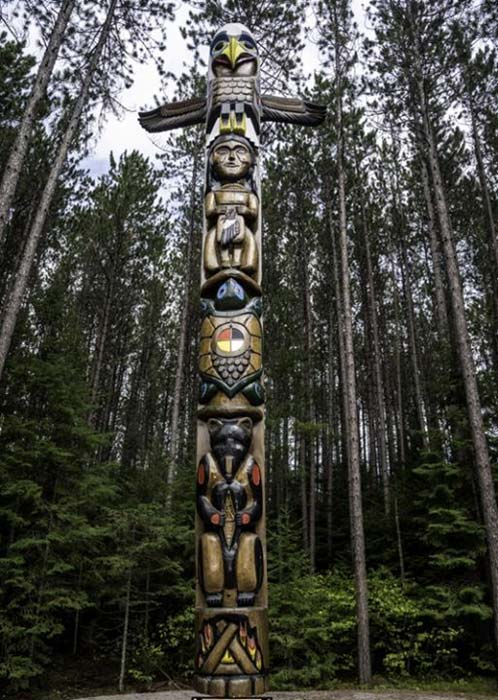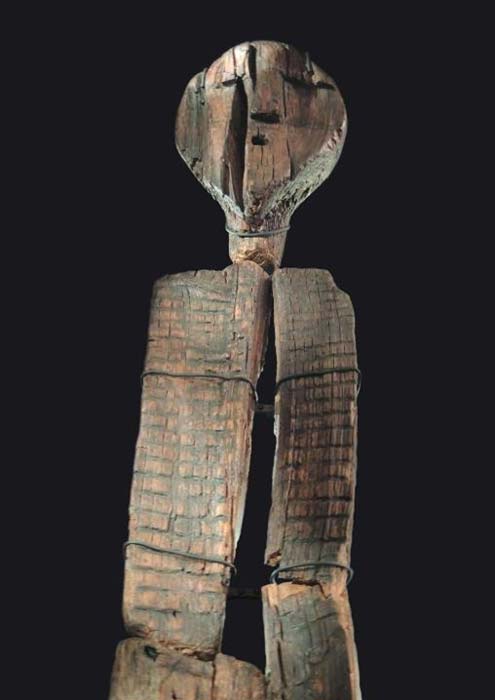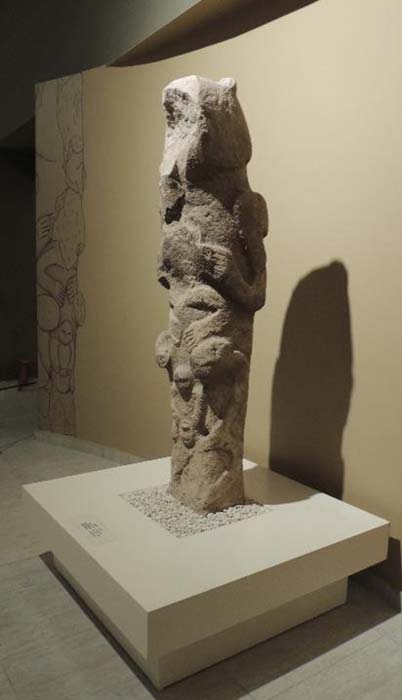
Puzzling Prehistoric Posts: The Enigmatic Spirit Poles of Eurasia
Totem poles are often seen as quintessential features of the Northwest Coast of America. Simon Fraser University lists ten types of American totem pole, which indicate their diversity and how the term “totem” can be misleading when applied to them. Over in Eurasia, there is a similar idea – spirit poles.
Common Totem Pole Types
Three common types of totem poles are: Memorial Poles, Welcome/Potlatch Figures, and House Posts. A Memorial Pole is one that is raised after the death of a chief or high-ranking person. The motives and symbols carved on it memorialize significant events in the life of the person.

Totem Pole in Algonquin Provincial Park, Ontario, Canada. (Public Domain)
Welcome/Potlatch Figures are raised and put in sight of guests arriving by water for a feast or gift-giving meeting. These anthropomorphic poles are usually depicted in welcoming postures. Related to Welcome/Potlatch Figures are Speakers Posts, which describe ancestral figures with open mouths. Speakers stand behind these poles and articulate as part of a greeting ceremony. Both these forms can be accompanied by a larger pole known as a Commemorative Figure, decorated with symbolic designs and family crests, stood outside the meeting house.
- Witchcraft, Worship or Public Shaming? The Puzzling Purpose of Totem Poles in North America
- The Totems Haida Gwaii, Canada: A Mortuary Pole for the Soul
- Native American Art: Thousands of Artists But Only a Fraction of Their Masterpieces Have Survived
A House Post is humanoid and architectural. Depending on the type of house, House Posts come in singles or doubles and support the beams of the roof. In addition to their appearance as supernatural beings, House Posts can also feature carvings signifying lineages and histories. The Hamatsa secret society relate a sacred legend in their ceremonies about an encounter with House Posts and the origin of the totem pole. When two brothers got lost on a hunting trip, they found a strange house with red smoke oozing from its roof. When they entered nobody was there but one of the house posts was a living woman. She warned them about the owner of the house, a dreadful man-eating giant with man-eating birds for his companions. When the giant returned, the brothers defeated him and took bird and bear masks and the first pole from the house.

‘Hamatsa Collage.’ (Alistair Coombs)
Northwest Coast poles are world renowned for their towering sizes and high degree of artistic workmanship. They are also part of a living tradition so that their meanings can be related. Whether or not the term totem is misapplied to them, they are essentially columns which represent ancestral or supernatural beings with extra ornamentations of cultural significance. Determining the age of pole traditions is difficult since they are often made of wood, which is not a material amenable to preservation; if left exposed to the elements they perish over the course of decades and centuries. Totem poles, however, reach back into prehistory and are not specific to America.
The Shigir Idol and Other Spirit Poles
In 1894, a large wooden statue was discovered at a depth of four meters (13.12 ft.) in a peat bog on the eastern slope of the Ural Mountains about 100 km (62.14 miles) from Ekaterinburg, Russia. Today, the Urals mark the boundary between western Russia and Siberia. The anthropomorphic sculpture became known as the ‘Shigir Idol’ named after the peat bog situated in an open-air gold mine, a site from which other prehistoric artefacts have been found, including arrowheads depicting waterfowl, a wooden bear head, amulets made of bear fangs, and an antler staff-head depicting a mythic beast combining wolf, boar and bear. The Shigir Idol was presented as a gift by the landowner to the Urals Society of Natural History, today the Sverdlovsk Regional Museum, Ekaterinburg.

Shigir Idol. (Alistair Coombs)
The Shigir Idol was made from the trunk of a larch tree split in half and probably stood at a height of about 5 meters (16.40 ft.), lower fragments of it have become lost. The statue is impressively old. In the 1990s, it was radiocarbon dated to an age of 9,500 years, which, at that time, was believed incorrect due to preconceptions about the capabilities of hunter-gatherers. In 2018, a Russo-German team re-dated the sculpture to 11,600 years, all the way back to the Early Holocene.
Naturally, the meaning of its symbolic elements has attracted different ideas; including encoded creation myths of the indigenous Ural peoples, or a navigational tool. Indigenous memory-systems specialist, Lynne Kelly, examines the use of totem poles as devices for storing knowledge without apparent writing systems, which becomes interesting in this respect.
Its series of vertical faces may represent divinities or different chapters concerning one. Notable is a recurring sevenfold symbolism, which includes seven identifiably human-like faces. The sculpture itself might have been a forest spirit, marker of a cosmic borderland, or even a “keep out” sign. The figure does not lack what we might term outré character.

Gobekli Tepe ‘totem pole.’ (Alistair Coombs)
Prehistoric Links Between Siberia and Anatolia
Other sculptures like the Shigir Idol have not been found, but it was most likely not a cultural anomaly. Its Late Glacial age led the research team to compare it with the earliest monumental anthropomorphic pillars of Gӧbekli Tepe, Southeast Anatolia, which are surprisingly contemporaneous in established date (9,600 BC). It is tempting to ask if the creation of these monuments was influenced by changing environmental conditions to which people at the close of the Ice Age were exposed. A “totem pole” with more similarity to the schemes of the Northwest American genre, but made of stone rather than wood, was also found in a later layer of Gӧbekli Tepe. It depicts three main motifs - two of which have been destroyed. On account of its ears and eyes, Klaus Schmidt suggested the upper had depicted the head of a bear.

Spirit poles at Lake Baikal. The various colors of fabric summon different classes of spirit. (Alistair Coombs)
Other research traces a continuity of shamanic ideas and images between prehistoric Siberia and Anatolia. Confronting the lack of early written sources among sub-Arctic shaman groups, the archaeologists Harald Haarman and Joan Marler examine material culture from the Ice Age settlement of Mal’ta west of Lake Baikal. In their analysis, this portable art, which includes figurines of waterfowl and bears, diadems, bracelets, and symbolically marked plaques, present a “refrigerator” of mythic prototypes around which belief systems of northern shamans crystallizes. Dating from 23,000 BC onwards, the Mal’ta iconography is, for them, a repertory of basic motifs which, despite stylistic variations and changes in material, define an enormous longevity of ideas across an interconnected zone of prehistoric culture which embraced Siberia and Anatolia.
- Göbekli Tepe Shamans and their Cosmic Symbols – Part I
- Oldest Wooden Statue in the World: The 11,000-Year-Old Shigir Idol
- Eerie Ancient Wax Sculptures for Hexing Enemies, Destroying Demons, and Remembering the Dead

Ancestor poles at the Novosibirsk Museum. (Alistair Coombs)
While there is no evidence of monumental forms on the scale of the Shigir statue, they note the spirit poles of later Altaic communities which mark sacred spaces and entrances to communities. These are the same poles which eventually moved westward to both sides of the Bering Strait. Though cultural elements change with unequal speed, the most stable are those which are considered sacred, despite cultural appropriations. The indigenous mythology of North America has long been regarded as “moderately Siberian” and this would include its pole traditions which, anthropologically, continue from prehistoric origins.

Totem poles at Kamchatka. (Alistair Coombs)
Top Image: Spirit poles on Olkhon Island, Lake Baikal, Russia. Source: Simon Matzinger/CC BY 2.0
References
American Indian Tradition and Continuity. (n.d.) “Mythology of the House of Hamatsa. American Indian Tradition and Continuity. Available at: http://naxnox.weebly.com/hamatsa.html
Berezkin, Yuri (2005) “Continental Eurasian and Pacific Links in American Mythologies and Their Possible Time-depth.” Latin American Indian Literatures Journal 21(2): 99-115
Haarman, Harald & Joan Marler Introducing the Mythological Crescent: Ancient Beliefs and Imagery connecting Eurasia with Anatolia. Wiesbaden: Harrassowitz Verlag 2008
Kelly, Lynne The Memory Code. London: Atlantic Books 2017
Simon Fraser University. (n.d.) “Totem Poles.” Simon Fraser University. Available at: https://www.sfu.ca/brc/art_architecture/totem_poles.html
Zhilin, M. et al. (2018) “Early art in the Urals: new research on the wooden sculpture from Shigir.” Antiquity. Available at: https://www.cambridge.org/core/journals/antiquity/article/early-art-in-the-urals-new-research-on-the-wooden-sculpture-from-shigir/1EE151AB1E571968B10267E48B78362A/core-reader
--
Bio: Alistair studied religion and archaeology (Silk Route) at the School of Oriental and African Studies and is finishing a PhD at the University of Kent. His work on prehistoric astronomy has been presented on the BBC, MSN and Science Illustrated.















